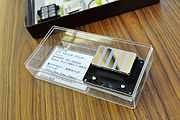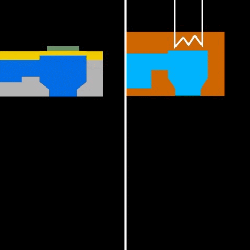Micro Piezo

Micro Piezo [1] is the brand name of the proprietary piezoelectric inkjet print head technology developed by Japanese imaging company Epson, which is also the only major printing company in the world to use piezoelectric technology throughout its entire inkjet printer range.[2]
How Micro Piezo technology works

Micro Piezo technology is based on the phenomenon of piezoelectricity where materials like crystals and ceramics (known as “piezoelectric materials”) react physically by bending, vibrating or expanding when an electrical charge is applied to them.
Micro Piezo print heads feature microscopic piezoelectric actuators that are built behind the print nozzles. When an electrical charge is applied to them, the piezoelectric elements bend backward, drawing precise amounts of ink from the ink chamber into the firing chamber. When the electrical pulse is reversed, the piezoelectric elements bend the opposite way very rapidly, propelling the ink out of the nozzles at high speed.
To improve print resolution, speed and gradations, Epson has refined its Micro Piezo technology to be able to precisely eject ink droplets of up to five different sizes by controlling minute variations in the charge applied to the piezoelectric actuators of the print heads.
History
Epson began research into using the piezoelectric effect for printing in the late 1970s. Subsequently, the company introduced its first printer that used piezoelectric technology for its print heads in October 1984: the Epson SQ-2000. This printer featured a pioneering piezoelectric print head that was made of glass and had vertical-firing piezoelectric elements.[3]
In 1990, a special team of 80 of Epson’s top engineers, headed by Minoru Usui (who is the current president of Epson), was assembled to develop an advanced piezoelectric inkjet head for future generations of Epson printers. Its mission was to develop a print head that could outperform laser and thermal inkjet printing technologies in terms of both cost and quality and that could eventually be developed to print at much faster speeds.
The team’s effort resulted in a new high performance piezoelectric print head that the company branded as "Micro Piezo" that was first used in the Epson Stylus 800 which was launched in March 1993. This new generation print head became the basis for all future Epson inkjet print heads up to today.[4]
Advantages

Compared to only other major inkjet printing technology, which is thermal inkjet printing technology, Epson claims that Micro Piezo technology has the following advantages:
- Micro Piezo technology allows for precisely controlled ink droplets of up to five different sizes to be ejected from the print head, resulting in sharper, grain-free photo prints with smoother tonal transitions.
- Print heads based on Micro Piezo technology have a far lower operation temperature, making them compatible with a wider range of inks that include specialized ones that use volatile solvents.
- The lower operating temperature of Micro Piezo print heads also makes them more reliable than thermal inkjet print heads. Therefore, printers with Micro Piezo technology use built-in fixed print heads that need not be changed for the lifespan of the printers. On the other hand, to ensure reliable operation, many thermal inkjet printers require ink cartridges with disposable print heads so that the heads are changed regularly when the ink cartridges are depleted. Therefore for printers of the same class, Micro Piezo printer ink cartridges tend to be more affordable and easier to recycle compared to thermal inkjet printer cartridges with disposable print heads.
Disadvantages
- As Micro Piezo print heads are built into the printers and are not replaceable by users, any damage to them will affect the print quality or render the printers inoperable until repaired. This compares to many models of thermal inkjet printers which use cartridges with disposable print heads. If any damage occurs to the print heads of such thermal inkjet printers, users can simply change the cartridge containing the damaged print head for a new one.
External links
- Epson website article explaining how Micro Piezo technology works
- How Stuff Works article explaining how thermal and piezoelectric inkjet printers work
References
- ↑ "Micro Piezo Technology introduction" - from Epson corporate website
- ↑ "Micro Piezo technology from Epson receives award" - by American Digital Imaging publication LetsGoDigital.com
- ↑ "The first commercial Epson inkjet printer" - from Epson corporate website
- ↑ "The first inkjet printer equipped with Micro Piezo technology" - from Epson corporate website